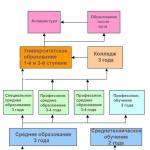White muscle disease (“muscular dystrophy”, “myopathy”, “waxy muscle degeneration”) is a serious disease of young farm animals and birds that occurs with violations of mineral, protein and carbohydrate metabolism, as well as with functional, biochemical and morphological changes in skeletal muscles and heart muscle.
The disease usually occurs in the second half of the winter - stall keeping of animals, in young animals in the first days and weeks of life, due to the fact that their mothers during pregnancy were not provided with sufficient and balanced feeding. Most often, lambs, piglets, calves, ducklings, and rarely foals are sick.
The disease has been known for a long time and is registered in most regions of Russia, including Vladimir, Nizhny Novgorod, Kostroma, Yaroslavl, Ivanovo.
White muscle disease is more often recorded in those places where pastures and grasslands are located in floodplain, low lands, often flooded during the spring flood, with a high content of sulfur, which is an antagonist of selenium and prevents its absorption by plants.
In the absence of treatment and preventive measures, the death rate of young animals reaches 50-70% of the number of cases. Young animals that have been ill with white muscle disease further lag behind in growth and development.
Etiology. The causes of white muscle disease are not well understood. Most scientists believe that white muscle disease is a specific violation of the vitamin and mineral nutrition of animals that occurs when there is a deficiency in the diet of microelements - selenium, cobalt, copper, manganese, iodine, vitamins A, B, E, as well as sulfur-containing amino acids - methionine and cysteine. Deficiency in the diet of the above substances, especially selenium and vitamin E has a negative effect on the intrauterine development of the offspring, and later on the growth and development of young animals. Concomitant factors aggravating the course of this disease include a violation of zoohygienic conditions of detention (crowding, dampness, poor ventilation, etc.)
Symptoms. In lambs, the disease begins in the first 2-3 months, but more often immediately after birth. Calves and piglets become ill during the milk feeding period or immediately after weaning.
The disease occurs in acute, subacute and chronic forms. For all forms, the following signs are characteristic - depression, weakness, stagnation, unsteadiness of gait, muscle tremors, paralysis of individual parts of the body.
acute form- characterized by severe clinical signs and severe cardiac disorders, gastrointestinal disorders, depression and paralysis of certain parts of the body. The heart rate reaches 140-200 beats per minute, heart sounds are deaf and weakened, splitting of the first tone, and with the development of pericarditis - splitting of the second and arrhythmia. Breathing is rapid, superficial and difficult, accompanied by participation in the act of breathing of the muscles of the abdominal wall and reaches 70-100 per minute. Serous-purulent exudate is released from the nasal cavities, sick animals move with difficulty, get tired quickly, and often lie down. Appetite is reduced and then disappears. Some animals have atony of the gastrointestinal tract, bloating, salivation, and gnashing of teeth.
Damage to the nervous system is characterized by lethargy, loss of muscle tone. The upper parts of the scapula protrude above the spinous vertebrae, the head is lowered, the legs are spread apart, then paresis of the limbs develops, turning into convulsions, in which the head is thrown back onto the back. The animal cannot stand up without assistance.
Body temperature is within the normal range, an increase to 40-41 degrees, when inflammation of the lungs is superimposed on white muscle disease.
Sometimes the disease can be blurred clinical signs Outwardly healthy animals suddenly die. The mortality rate of young animals in the absence of timely and well-conducted treatment reaches 60-90%.
For subacute and chronic forms disease symptoms are the same as in acute, but less pronounced. The subacute form lasts 15-30 days, with chronic 50-60 days and mortality reaches 4-60%.
A characteristic symptom of white muscle disease at autopsy is - diffuse or focal damage to the heart muscle and skeletal muscles, which are clearly visible in the transverse section of the heart and a large group of muscles of the pelvic limbs. They have diffuse or focal lesions in the form spilled whitish color, dense consistency, dryish and reminiscent of boiled chicken(hence the name white muscle disease)
Treatment. Specific treatment has not been developed. The best therapeutic effect occurs with the use of selenium preparations. For subcutaneous and intramuscular administration, 0.1 -0.5% percentage solutions of sodium selenite are used. They are prepared aseptically in sterile distilled water; sodium selenite solutions are colorless, transparent, unstable and do not withstand boiling. Solutions are suitable for use only on the day of preparation.
In farms of lambs disadvantaged for white muscle disease, sodium selenite is administered subcutaneously for prophylactic purposes to pregnant wombs, once at a dose of 4-6 mg per animal (0.8-1.2 ml of a 0.5% solution) 20-30 days before lambing. When white muscle disease appears among young animals, a solution of sodium selenite is administered once to all young animals subcutaneously or intramuscularly at a dose of 0.1-0.2 mg / kg (0.1-0.2 ml 0.1% solution)- lamb weighing 2 kg - 0.2-0.4 ml of 0.1% sodium selenite solution.
The use of selenium preparations is allowed only for veterinarians with higher or secondary specialized veterinary education!
Based on practice - before the mass use of the drug, we recommend checking selenite for toxicity by introducing its solutions to a preliminary control group of animals - 5-6 animals. In the absence of toxic effects, we process the entire livestock. Sodium selenite is highly toxic and must be stored as medicines. groups A., and since its use causes complications at the injection site in the form of abscesses, the solutions are used simultaneously with a therapeutic dose of an antibiotic dissolved in a solution of sodium selenite.
For therapeutic purposes can be applied vitamin E, but it is less effective than sodium selenite. It is used for pregnant sheep a month before lambing, for lambs - within 2-4 weeks after birth with food. doses of vitamin E: sheep - 10-20 mg, lamb 5-10 mg. on the head 2-3 times a day. Complex preparations are also used - selevit containing in 1 ml.
Tocopherol acetate 25 mg and sodium selenite 2.2 mg, it is administered subcutaneously or intramuscularly to lambs up to 3 weeks 2 ml, older than 3 weeks - 4 ml, calves, foals, piglets 2 ml per 10 kg of body weight. A drug SELEVIT ADULTOS contains vitamin E 7.5g, sodium selenite-75mg per 100ml, selferol contains 0.5mg sodium selenite per 1ml and vitamin E 150mg.
Microelements are introduced into the diet - cobalt chloride, copper sulfate, manganese chloride, the use of sulfur-containing amino acids (methionine, cysteine) is useful. Symptomatic treatment is carried out: in case of heart failure - cordiamine 1.5-3 ml, camphor oil-3-5 mg. With complications - antimicrobial drugs.
Prevention. Based on the elimination of the causes of white muscle disease.
Proper conditions for feeding and keeping pregnant animals and offspring are being created. Apply microelement polysalts and vitamin preparations. One month before delivery, as well as for newborn calves, lambs and piglets, we inject 1 ml intramuscularly or subcutaneously 0.1% sodium selenite solution. Prophylactic doses selevite, SELEVIT ADULTOS, selferol 2 times less than therapeutic, and tocopherol 3 times.
Recently, an oral method has been developed for the prevention of white muscle disease in sheep, by using the drug "Bentoselen", in the form of tablets of 0.25 g for lambs and 0.5 g for ewes. Lambs are given it by mouth, twice, on the 2nd-3rd and 25th-30th days of life at a dose of 30 mg per kilogram of live weight, and pregnant ewes at 15 mg per kilogram of body weight 25-30 days before lambing.
For the prevention of white muscle disease of young farm animals, the industry also produces premixes for sheep ().
Kira Stoletova
White muscle disease of calves is a common disease that belongs to one of the severe endemic diseases of young agricultural animals.

Etiology of the white mouse
White muscle disease of young animals is little studied. It can affect the body not only of calves, but also of other representatives of cattle in agriculture: sheep, lambs, goats. Cases of the disease were recorded in piglets, white muscle disease was noted in poultry - chickens and ducklings.
It is associated primarily with deep forms of violation of various metabolic processes, including vitamin-mineral, protein-carbohydrate. This disease of cattle and poultry leads to disturbances in the activity of the heart muscle, deforms the skeletal muscles, and leads to morphological changes in the internal organs and tissues.
In Russia, the so-called white mouse among farmers was recorded in Yakutia and Buryatia, in the Amur Region. Cases of young cattle with this disease were noted in Arkhangelsk and Yaroslavl.
Among the reasons for the appearance of the white mouse in young cattle and poultry, as well as among adults, scientists tend to consider a lack of selenium, amino acids such as methionine and cystine, vitamins A and E. The role in the causes of the disease is played by the lack of copper component in feed consumed by livestock , manganese, cobalt element, iodine. In addition to these reasons, an important role in the etiology of white muscle disease is played by inadequate nutrition of cattle and poultry during pregnancy, as well as young animals during the suckling period. The white mouse may be facilitated by inappropriate conditions for keeping animals.
Symptomatic signs
In the course of the disease, young cattle and poultry emit:
- The acute course of the disease, in which the main clinical symptoms are noted unmistakably, manifesting themselves pronouncedly. In this form, the disease is usually carried by animals at a very early age.
- The subacute stage proceeds slowly at the age of 1 week to 2 months.
- The chronic form usually appears when the calves reach the age of 2-3 months and older.
Signs of 3 forms of the disease
The acute form of white muscle disease of calves and other cattle and poultry is accompanied by a general weakening of the animal organism, their movements become constrained, trembling and convulsive states are often noted. After some time, other symptoms develop: paralysis of the limbs or individual parts, paresis. With such a course of the white mouse, the functioning of the cardiovascular system is clearly disrupted, manifesting itself in the form of a frequent pulse, reaching up to 140-180 beats per minute, accompanied by weak and muffled heart tones. There is nowhere to put a rapid heartbeat, leading to the development of arrhythmias.
The subacute form of development of the white mouse as a symptom shows a change in the work of the heart muscle, which leads to difficulty in movement in animals. Cattle rise with difficulty, often lie down, pets have a shaky gait due to muscle weakness. In addition to these symptoms, convulsive states and paralysis are noted.
The chronic course of the white mouse is characterized by a clear depletion of the organisms of cattle and poultry and a slowdown in the growth of young animals. There is heart failure and developed anemia.
The last two forms of the course of the disease in calves can lead to complications - bronchopneumonia and gastroenteritis, if timely treatment is not carried out.
Diagnosis and treatment
Diagnosis of the white mouse in cattle and poultry is carried out on the basis of laboratory tests to detect pathological changes. In addition, the conditions for feeding and keeping animals are being studied, taking into account regional differences in soil and climatic conditions, in order to prescribe the correct and timely treatment.
An autopsy of the corpses of sick individuals shows heart lesions that look like whitish or yellowish necrotic foci. In focal lesions of skeletal muscle tissues, the appearance of boiled chicken meat is of diffuse origin, which is why the white muscle gave the name to the disease.
The initial measure in the treatment of sick young animals is to improve the quality of their maintenance, which certainly includes improving the composition of the diet and providing young animals with the necessary mineral and vitamin components.
As an effective remedy, proven by farmers and veterinarians, 0.1% sodium selenite is used, which is injected subcutaneously or intramuscularly, depending on the weight of the animal. For 1 kg of weight, from 0.1 to 0.2 ml of solution should be taken. Sodium selenite is able to normalize metabolism.
Treatment of heart failure in calves and lambs can be carried out by the use of camphor and caffeine, increased time of walking animals in the fresh air, ultraviolet radiation in the winter.
In addition to oral injections for white muscle disease of young animals, a three-time use of tocopherol acetate is prescribed. It is necessary to give it to sick animals before feeding for a week, 10-12 mg each.
Treatment of sick calves and lambs often uses hydrolysates, which are administered intramuscularly in 50 ml doses throughout the week. For intramuscular injections, water solutions based on methionine or cystine can be used for 4-5 days, 0.1-0.2 g each.
In areas unfavorable for white muscle disease of cattle, veterinary services recommend prophylaxis in the form of injections using preparations containing selenium and vitamin E.
A set of measures for the prevention of white mice should include the mandatory regulation of biogenic processes, for which fertilizers are applied to the soil layers in regions with frequent fixation of cases of the occurrence of white muscle disease of animals, pasture meadows are sown with protein-containing legumes.
Prevention for young animals includes the appointment of sodium selenite in the first days of life - once a month 8-10 mg for calves. White muscle disease of lambs is prevented by giving 1-2 mg of selenite, piglets - 2 mg.
In winter, as a vitamin supplement for calves, piglets and lambs, α-tocopherol is fed or administered as a subcutaneous injection.
White muscle disease of calves can occur in young animals in the first days or weeks of life. This pathology is characterized by a violation of almost all types of metabolism: carbohydrate, mineral, lipid and protein. In a sick calf, muscle changes are observed that occur with myopathy, muscular dystrophy and damage to the heart muscle. This disease (or as it is also commonly called “white mouse”), if not treated in a timely manner, causes the death of livestock in 60% of cases. The most severe course of the disease is observed in the winter and spring periods. This disease occurs mainly in the zone with peat, podzolic and sandy soil.Features of white muscle disease
White muscle disease of young animals most often occurs in those animals whose mothers did not receive sufficient and complete nutrition during pregnancy. There is also an opinion that the disease appears due to a lack of selenium, protein and vitamin A in the feed.
Most cases of the disease are recorded in places with a high concentration of sulfur in the soil, which is an antagonist of selenium. With an increase in the moisture content in the soil, a lot of sulfur dissolves in it, which prevents the absorption of selenium by plants.

An accompanying reason for the development of white mice in young animals is considered to be improper conditions for keeping livestock, for example: high dampness in the room, crowded content or poor ventilation.
Recently, there has been an opinion that this disease is a symptom of vitamin E deficiency in the body.
White muscle disease can also occur in young animals of other species of animals and birds. In the blood of a sick animal, a decrease in total protein and an increase in nitrogen are observed. A characteristic indicator for the disease may be a violation of creatinine metabolism and a high content of phosphorus.
Most often, this disease occurs in Australia, the United States and New Zealand.
Symptoms and forms of the disease
During the autopsy, it is revealed that the affected young animals have obvious symptoms of exhaustion. This disease is characterized by the following clinical manifestations:
- swelling of the subcutaneous tissue;
- symmetrical damage to skeletal muscles;
- erased pattern of fibers;
- enlarged heart;
- hyperemia of the lungs;
- softening of the brain.

There are such forms of the disease in young animals:
- acute form;
- subacute form;
- chronic form.
acute form
The acute stage begins abruptly with pronounced symptoms and lasts about 7 days. The animal feels a breakdown, is in a depressed state and often lies down. There is muscle tremor, paralysis of some limbs and gait is disturbed.
Breathing becomes rapid and difficult, there are symptoms of a violation of the heart and gastrointestinal tract: fetid feces, swollen intestines, serous discharge from the eyes and nose.
When the clinical picture is erased, the animal may look outwardly absolutely healthy and die suddenly, for no apparent reason.
Subacute form
In the subacute form, the disease has less pronounced symptoms and lasts from two weeks to 30 days. If the necessary treatment is not carried out at this stage, the mortality rate is from 40 to 60%. In a sick animal, wheezing appears, appetite disappears or weakens, and in the presence of complications, pneumonia or pleurisy appears.
Chronic form
The chronic form of the disease is mainly found in young animals over the age of 3 months. It is a consequence of the lack of treatment or improper content. Clinical manifestations are the same as in other forms, but developmental delay, exhaustion and low mobility of the animal are added to them. Sometimes the calf is not able to rise on its hind limbs.

Diagnostics and treatment-and-prophylactic measures
During the diagnosis, clinical manifestations, the age of the animal and the results of the tests are taken into account. Since the white mouse may not occur every year, information on the disease is collected for past years.
If possible, electrocardiography, fluoroscopy and radiography are performed. The disease is differentiated from enzootic ataxia.
There is no specific treatment, but the maximum therapeutic effect is observed after the use of selenium, tocopherol, trivitamin, sulfur-containing amino acids and protein hydrolysates.
Treatment will be effective only if complex treatment is carried out, namely, a combination of drug therapy with good living conditions, isolation of a sick animal, good nutrition and quality care.
Prevention of the development of white muscle disease of calves consists in the introduction of a solution of sodium selenite or tocopherol to pregnant animals and newborn calves.
At the first signs of illness in young animals, it is necessary not to self-medicate, but to contact the veterinary service. This will help not only to help sick animals in time, but also to warn against further infections.
Cattle calves are extremely sensitive to improper housing conditions, unbalanced diet and other adverse factors. Against their background, various dangerous diseases often develop. Among them is white muscle disease of calves, which involves the death of young animals in 60% of cases.
Symptoms
White muscle disease (popularly called the white mouse, also called myopathy in scientific sources) can be traced in calves, lambs, and some varieties of poultry. It is accompanied by severe muscle dystrophy and impaired metabolism of nutrients and minerals in the body. Also, the heart muscle is often negatively affected, which carries a particularly great risk to the life of young animals.
Reliable causes of the development of the disease in animals are unknown. Most researchers agree that it occurs as a result of a lack of certain vitamins and minerals in the body. Most often, outbreaks of the disease are recorded in the winter-spring period.
The following clinical manifestations are characteristic of the white mouse in an acute form:
- general oppression;
- loss of appetite;
- diarrhea;
- clouding of the eyes, which is accompanied by serous discharge from the conjunctiva;
- the same serous exudate is released from the nasal cavity;
- profuse salivation;
- rapid breathing and pulse;
- frequent convulsions;
- the calf can fall sideways and lie in this position for a long time without getting up.
In addition to convulsions, atypical movements, a constantly lowered head, and paralysis of certain parts of the body also indicate serious changes in the nervous system. Also, the disease is often accompanied by bloating.
All of these symptoms can appear together or separately. In some cases, the disease is completely asymptomatic.
Forms
The disease in cattle calves can manifest itself in three main forms:
- Acute.
- Subacute.
- Chronic.
acute form
In this form, the disease in most cases manifests itself with a complete list of clinical signs. It is accompanied by general depression, rapid breathing, disturbances in the work of the intestines, convulsions and paralysis of the limbs. There must be discharge from the eyes and nose.

This form of the disease has the highest mortality rate. The disease lasts in young animals for 7 days.
In rare cases, the acute form of the disease may be asymptomatic. In this case, it ends in sudden death. At the same time, it is almost impossible to identify the disease.
Subacute form
In the subacute course, the symptoms are less pronounced. It is characterized by mild depression, loss of appetite, wheezing in the chest area. It is worth noting that this form of the white mouse significantly reduces the body's resistance, making it vulnerable to other diseases. As a result of this, the baby also often develops pleurisy and inflammation.
On average, this form lasts 14-30 days. And in 60% of cases it ends with the death of the animal.
chronic course
This manifestation is typical for young animals whose age has already exceeded 3 months. Symptoms in this case are similar to the clinical picture of acute and subacute forms. The development of the animal slows down sharply, muscular dystrophy is traced.
Attention! The cause of the development of the chronic course of the disease is violations of the conditions of detention and improper treatment of a newborn baby.
Diagnostics
Diagnosis of myopathy is carried out in a complex manner. Clinical manifestations and the results of the tests performed are taken into account. The data obtained are necessarily compared with the age of the calf to exclude similar diseases.
For the implementation of intravital diagnosis of the calf, fluoroscopy is performed. To study the nature of the work of the heart, electrocardiography is prescribed. It allows you to determine the damage to the heart muscle.

In the event of the death of a calf, myopathy is detected in it on the basis of characteristic pathological changes:
- obvious damage to skeletal muscles;
- enlarged heart and lungs;
- swelling in the fiber layer;
- the brain is softened.
Treatment
With the final diagnosis, the correct treatment of the animal should be organized as soon as possible. And the first thing to do is to transfer the sick baby to a separate box. There he is isolated from the rest of the herd, provided with warm bedding, plenty of water and a special diet. According to the recommendations of the veterinarian, it may include:
- carrot;
- quality hay;
- bran;
- fresh dairy products.
The box in which the animal is kept should be regularly cleaned of food debris and manure.
After organizing the proper conditions of detention, basic medical measures are carried out. There are no specific drugs to treat white muscle disease. Therefore, for this purpose, use:
- Sodium selenite in the form of a solution. It allows you to compensate for the lack of selenium in the body of the calf. The drug is injected subcutaneously.
- Methionine. This amino acid contributes to the resumption of disturbed metabolic processes.
- Tocopherol. It is also responsible for the normalization of metabolism.
- Cysteine.
Clear dosages of drugs are determined by the veterinarian in each case.
Additionally, camphor oil and cordiamine are introduced into the treatment course, which allow normalizing the functioning of the calf's heart. With the complication of the underlying disease, secondary antibiotics must be used.
Important! Copper sulfate and chlorides of manganese and cobalt must be added to the feed in small quantities. They help the body absorb vitamins and nutrients more intensively, and also promote the production of blood cells.
Prevention
The main preventive measures in the fight against myopathy include:
- ensuring full conditions for keeping and feeding young animals;
- ensuring proper care of pregnant heifers;
- widespread use of vitamin and mineral complexes in livestock farms.

An effective way to prevent white mice is also injections of tocopherol and sodium selenite, which are sold for pregnant heifers and newborn calves. It is only worth considering that the prophylactic dose of the drug should be significantly lower than the therapeutic norm.
Conclusion
White muscle disease is one of the most dangerous diseases of young cattle. It assumes a high mortality of calves, and in those cases when the animal still gets sick, it can no longer catch up with its peers in development. Therefore, every cow breeder must know exactly the main signs of such a disease and how to provide first aid to the baby.





